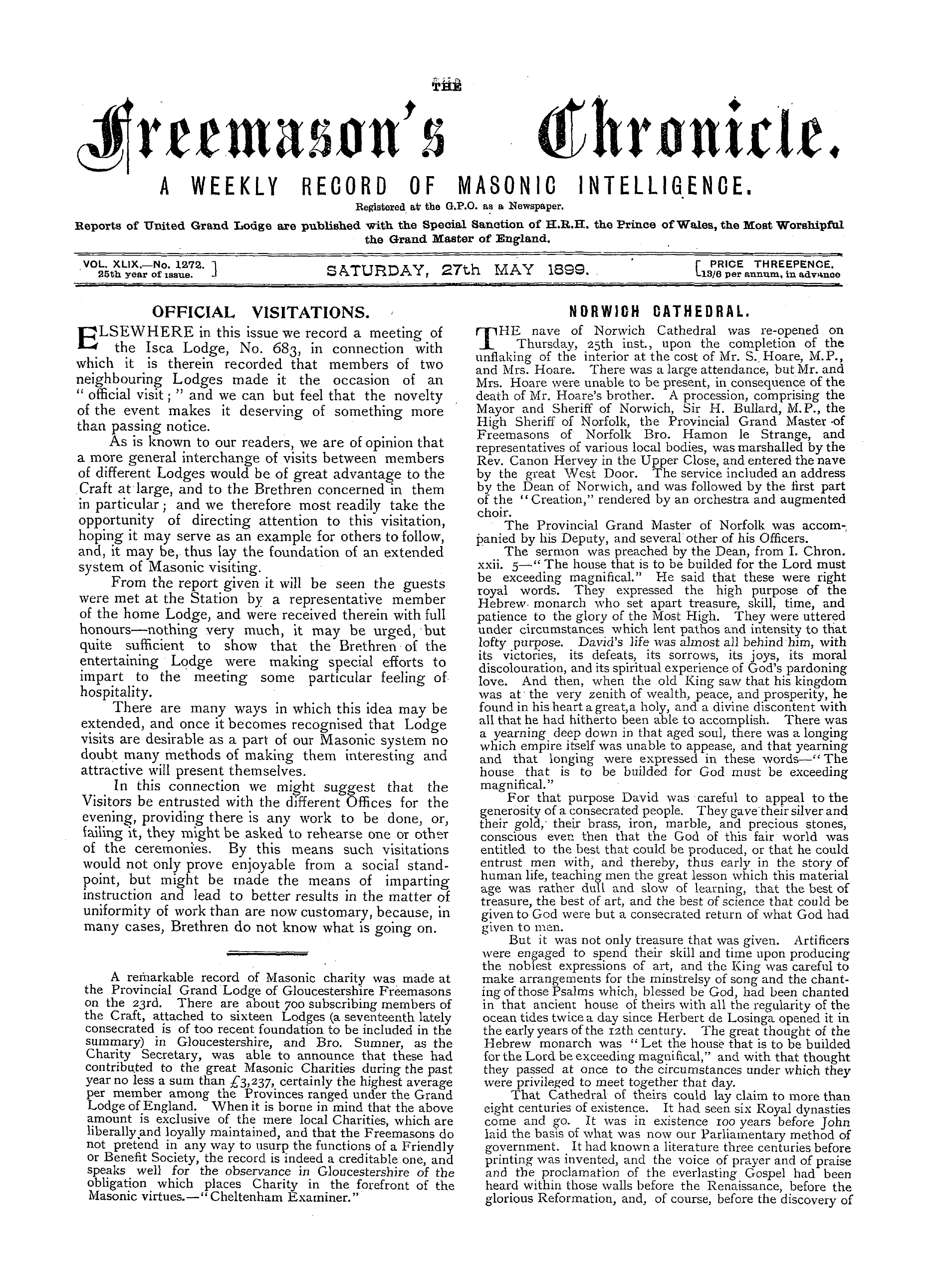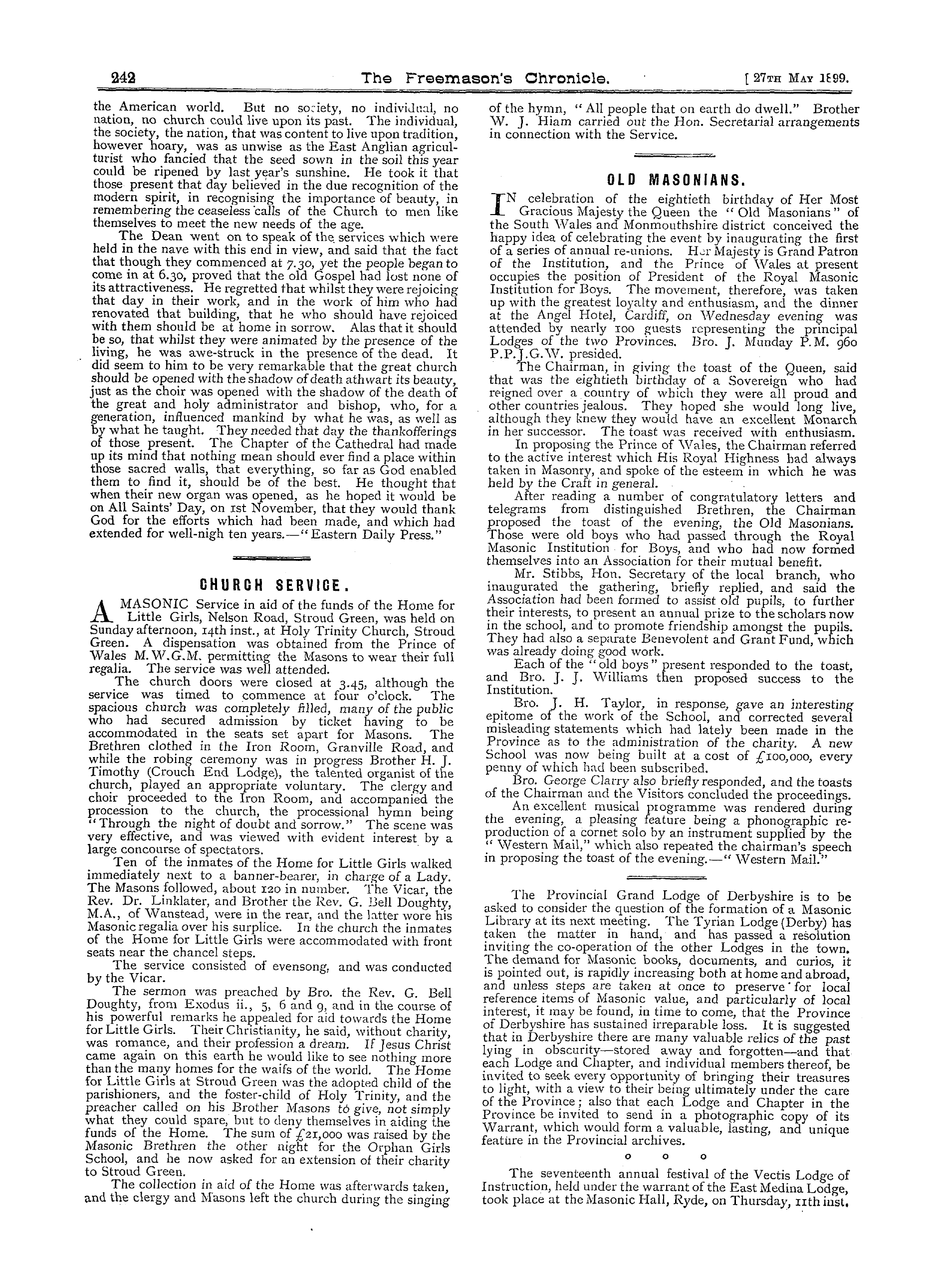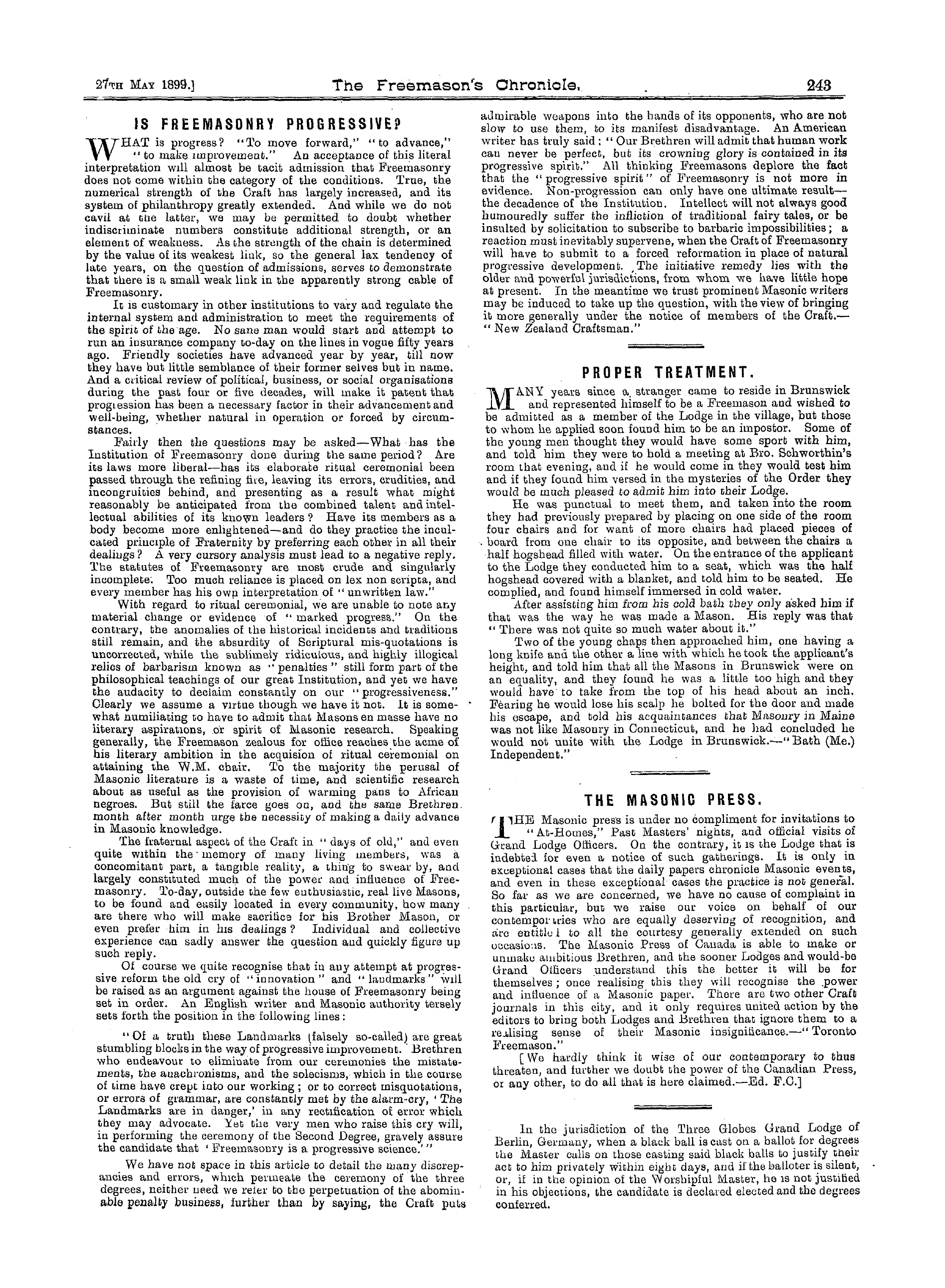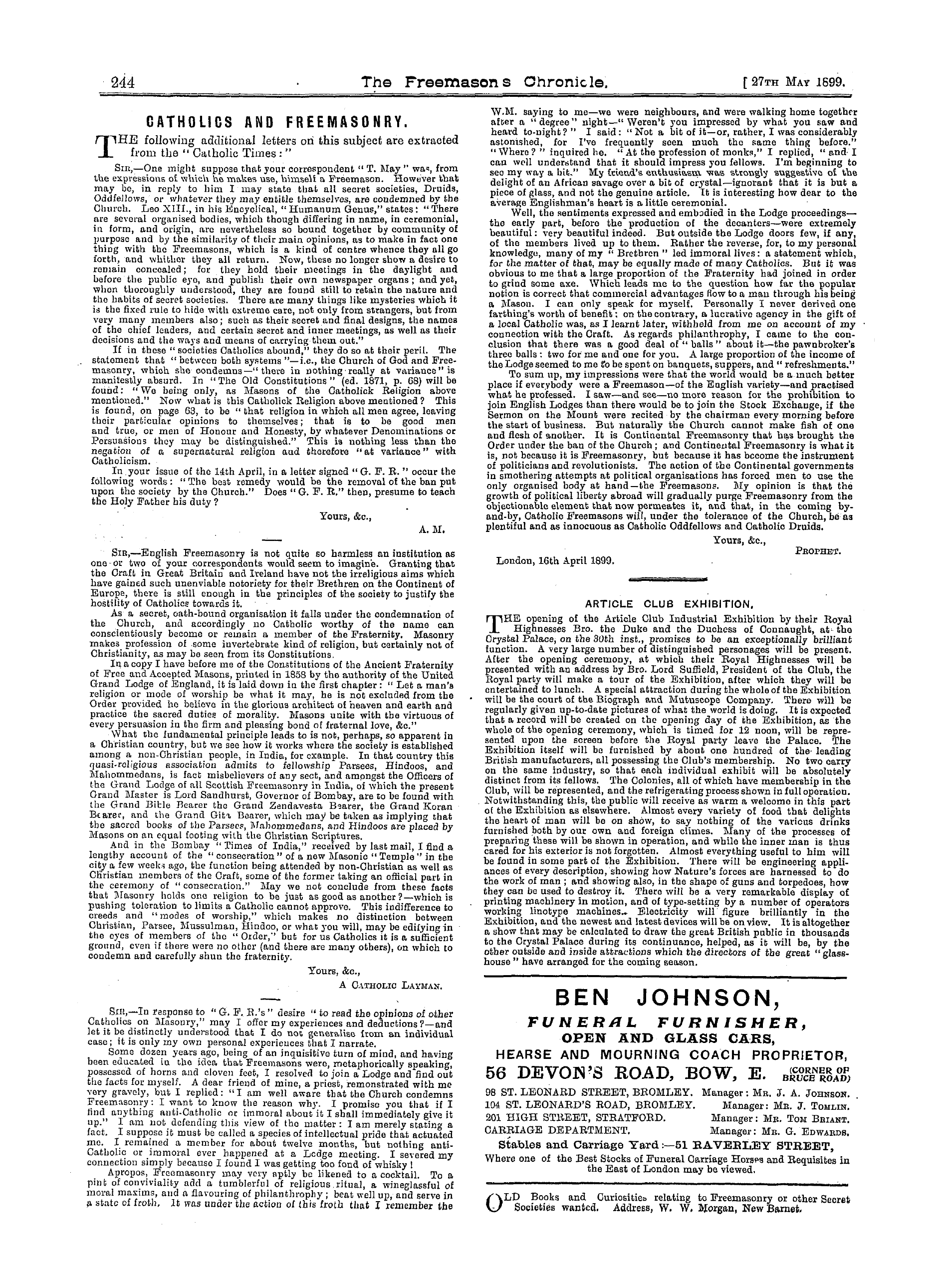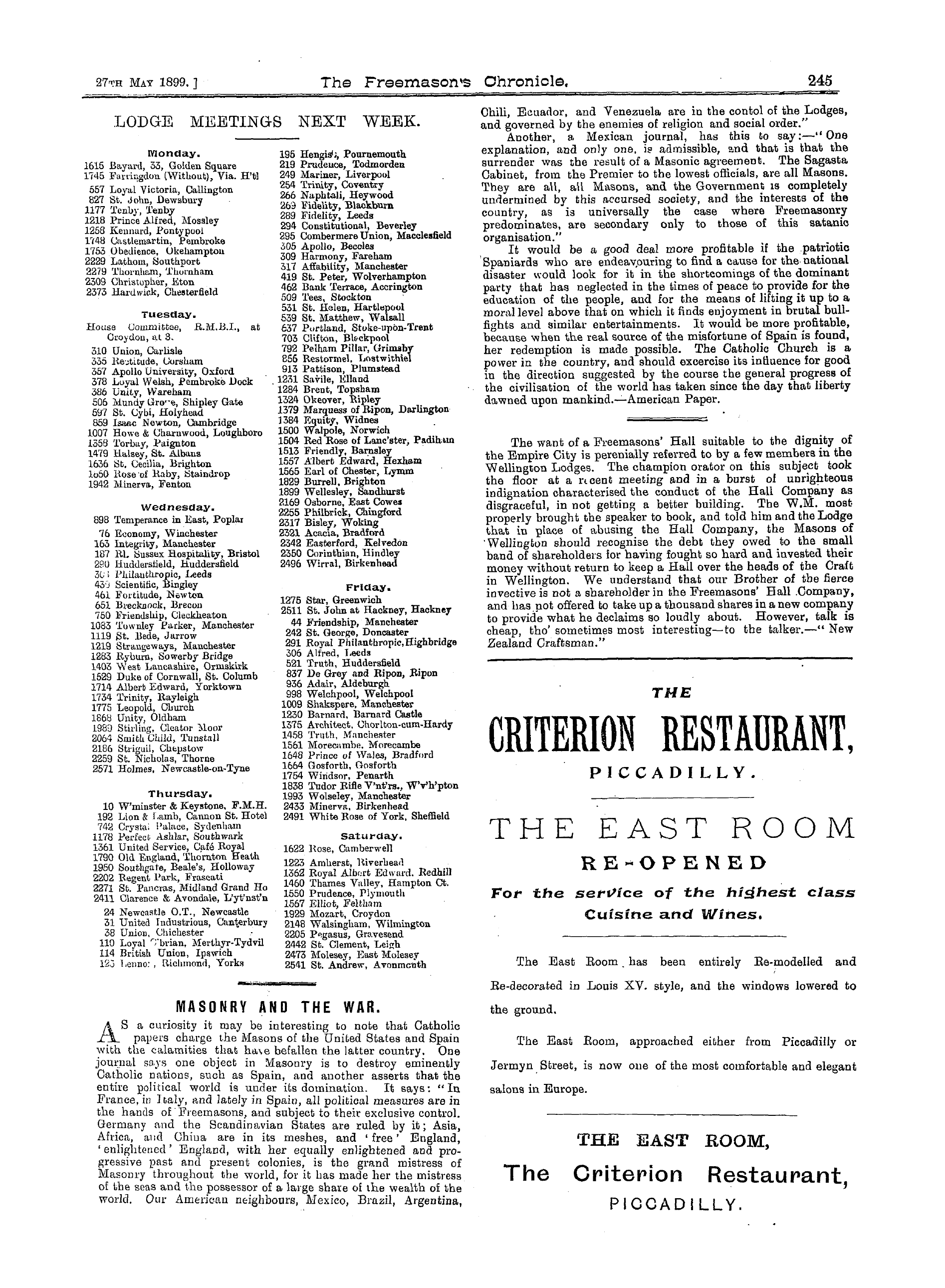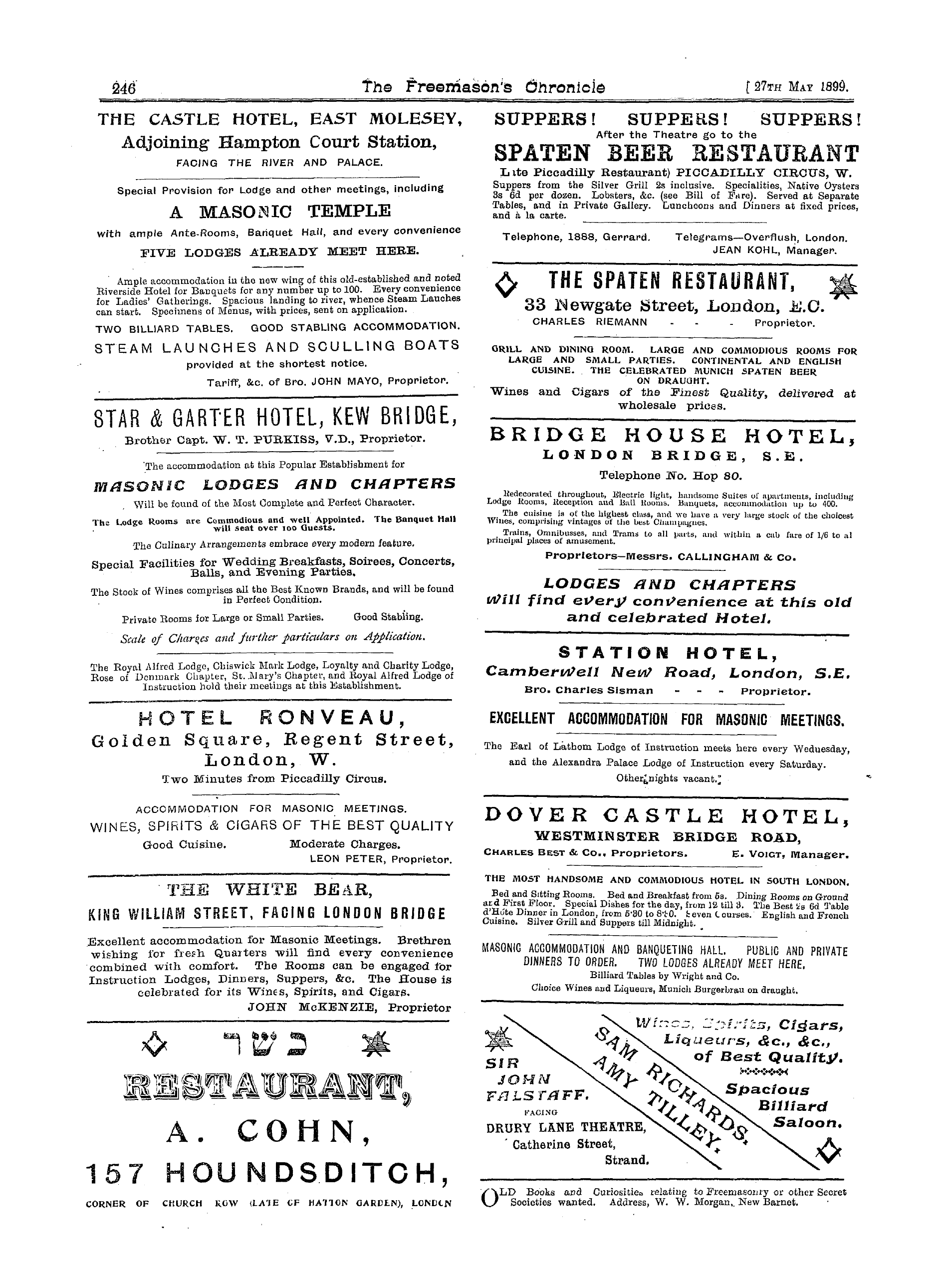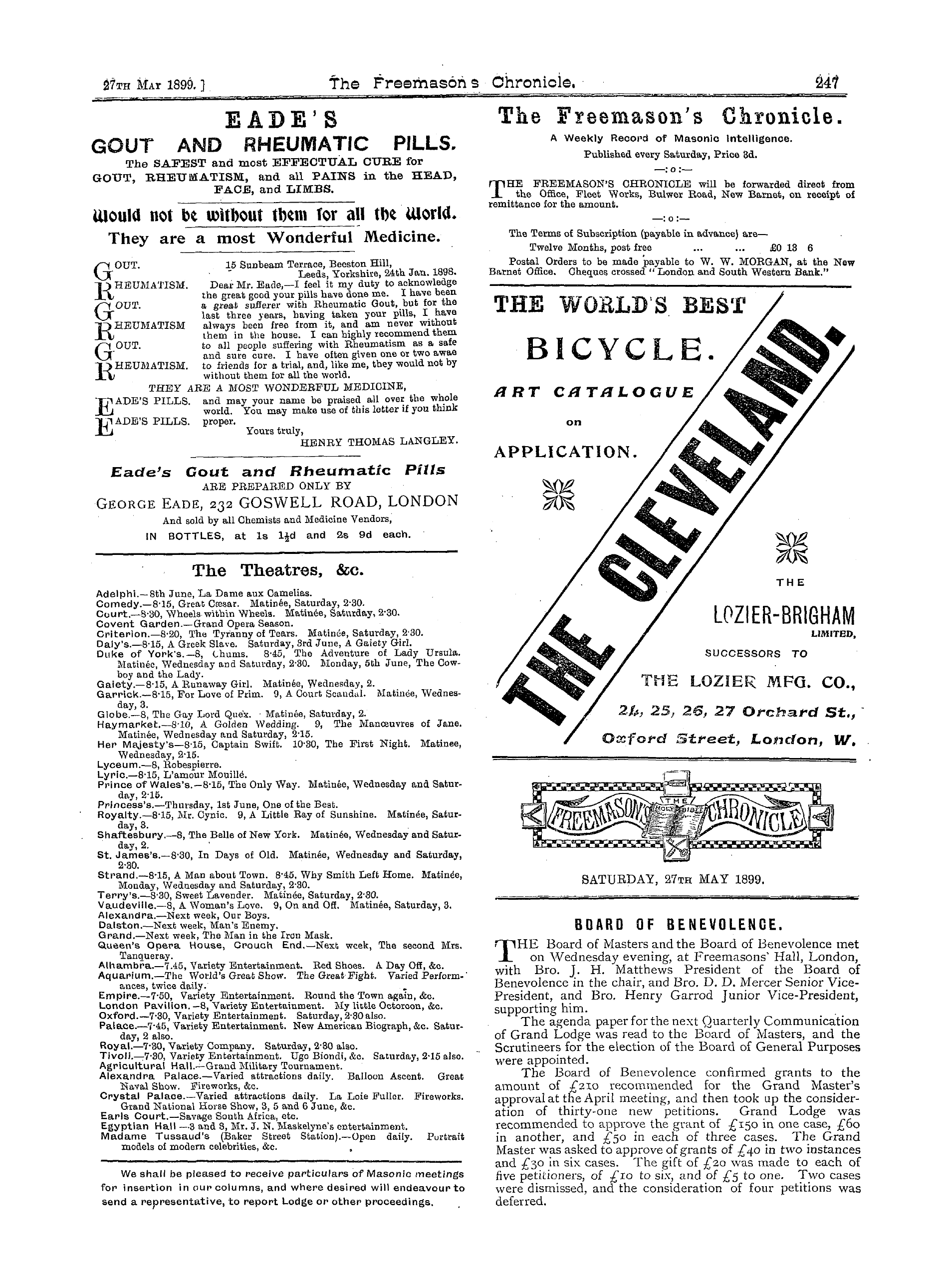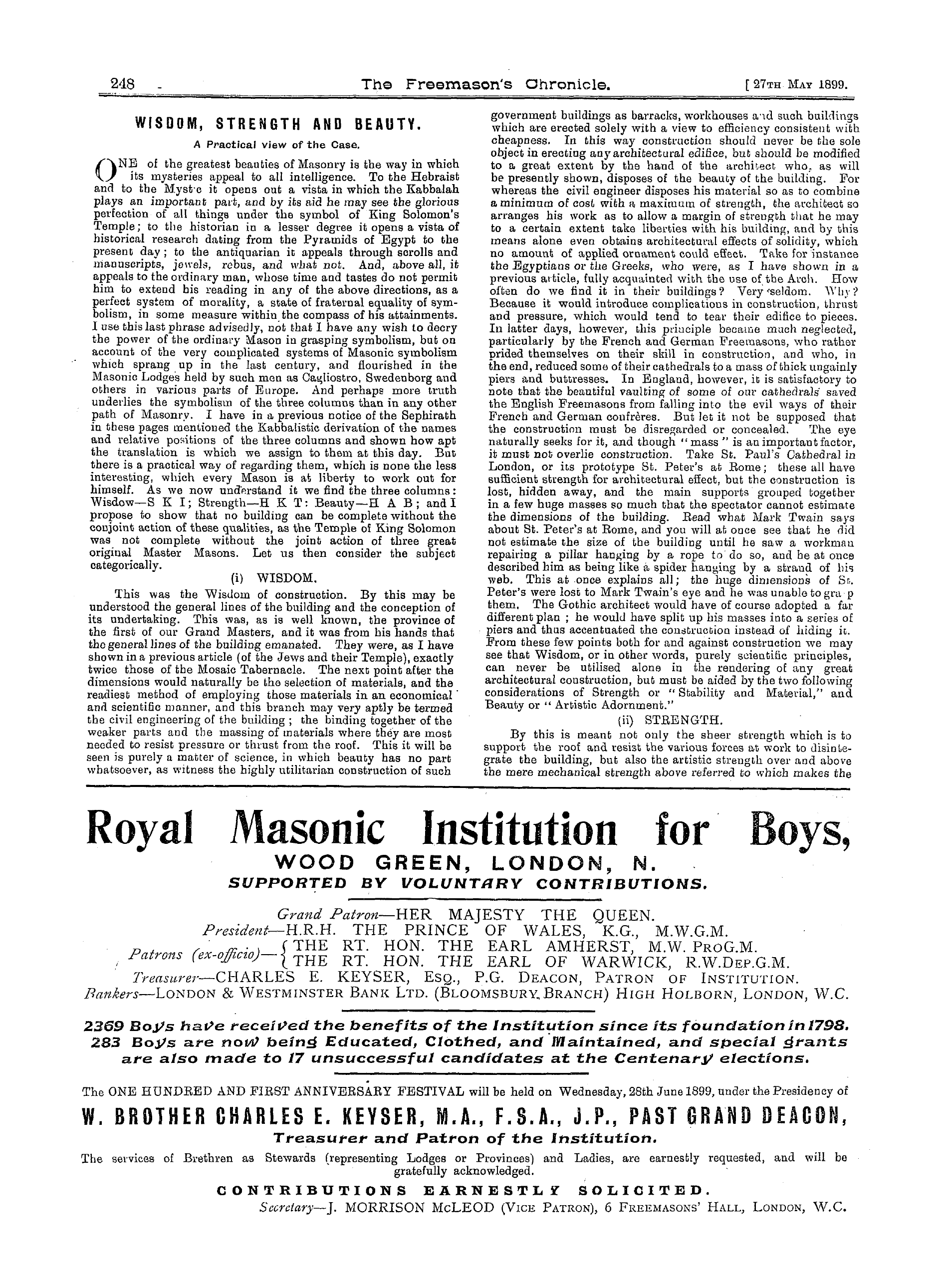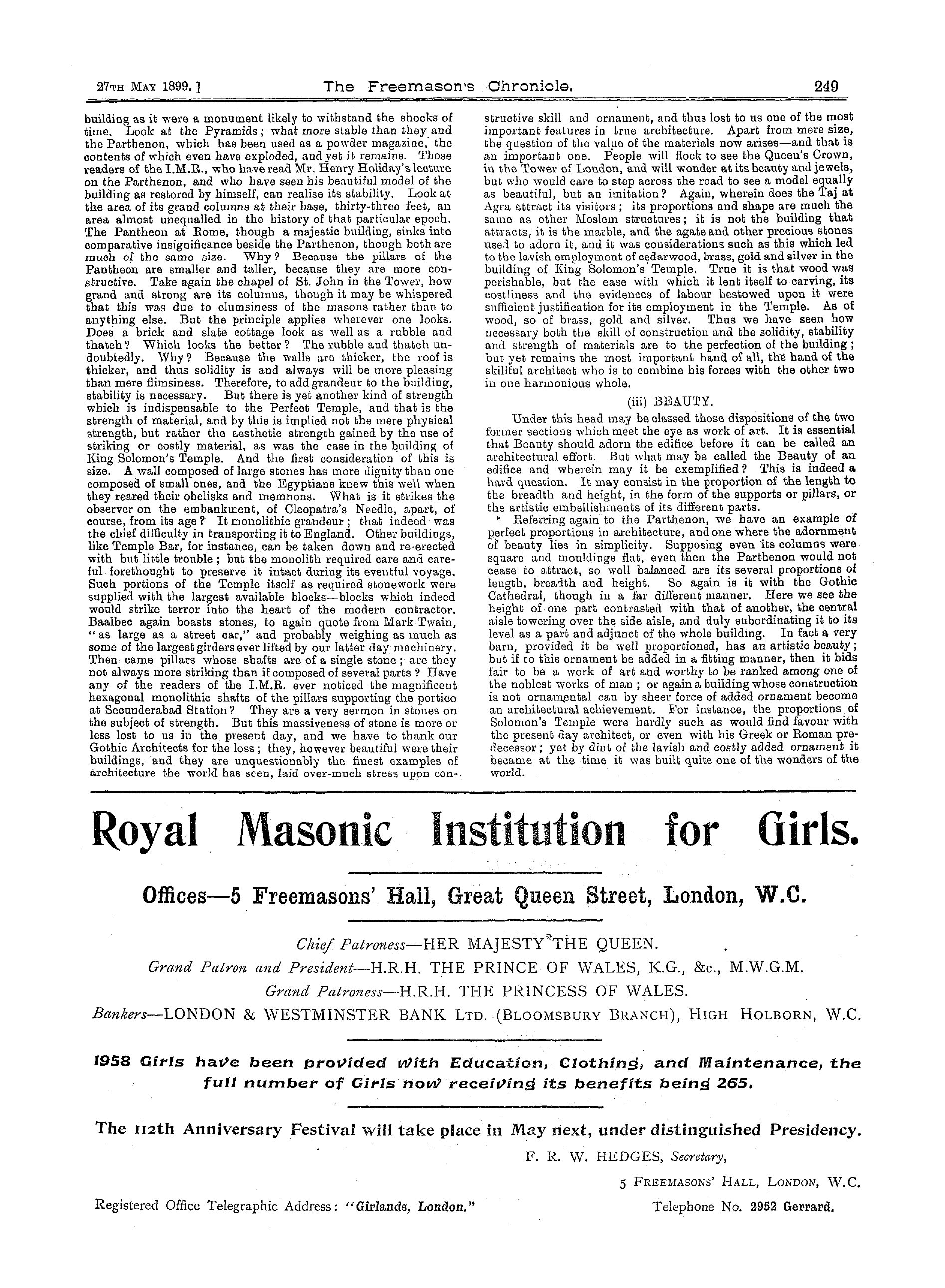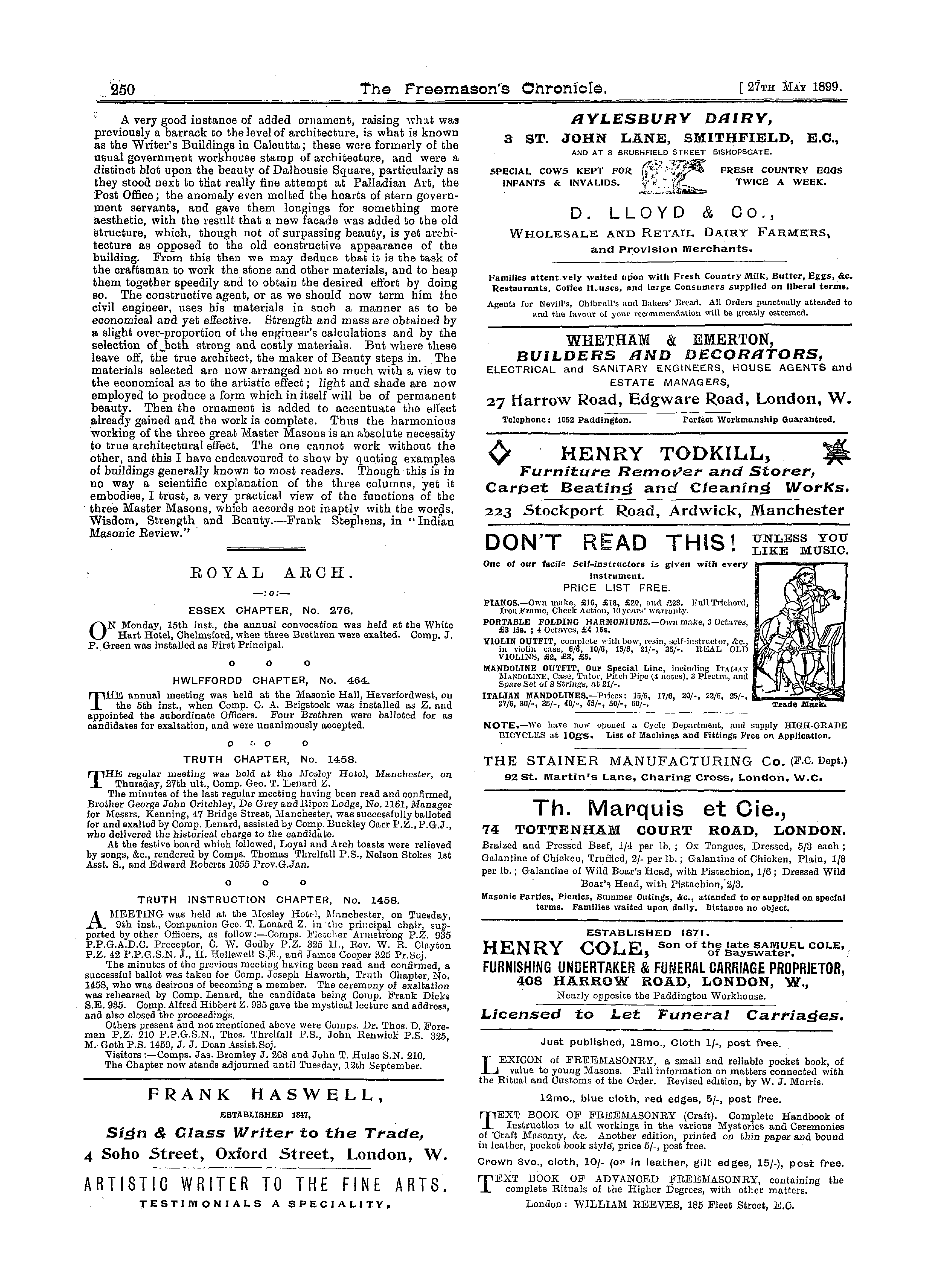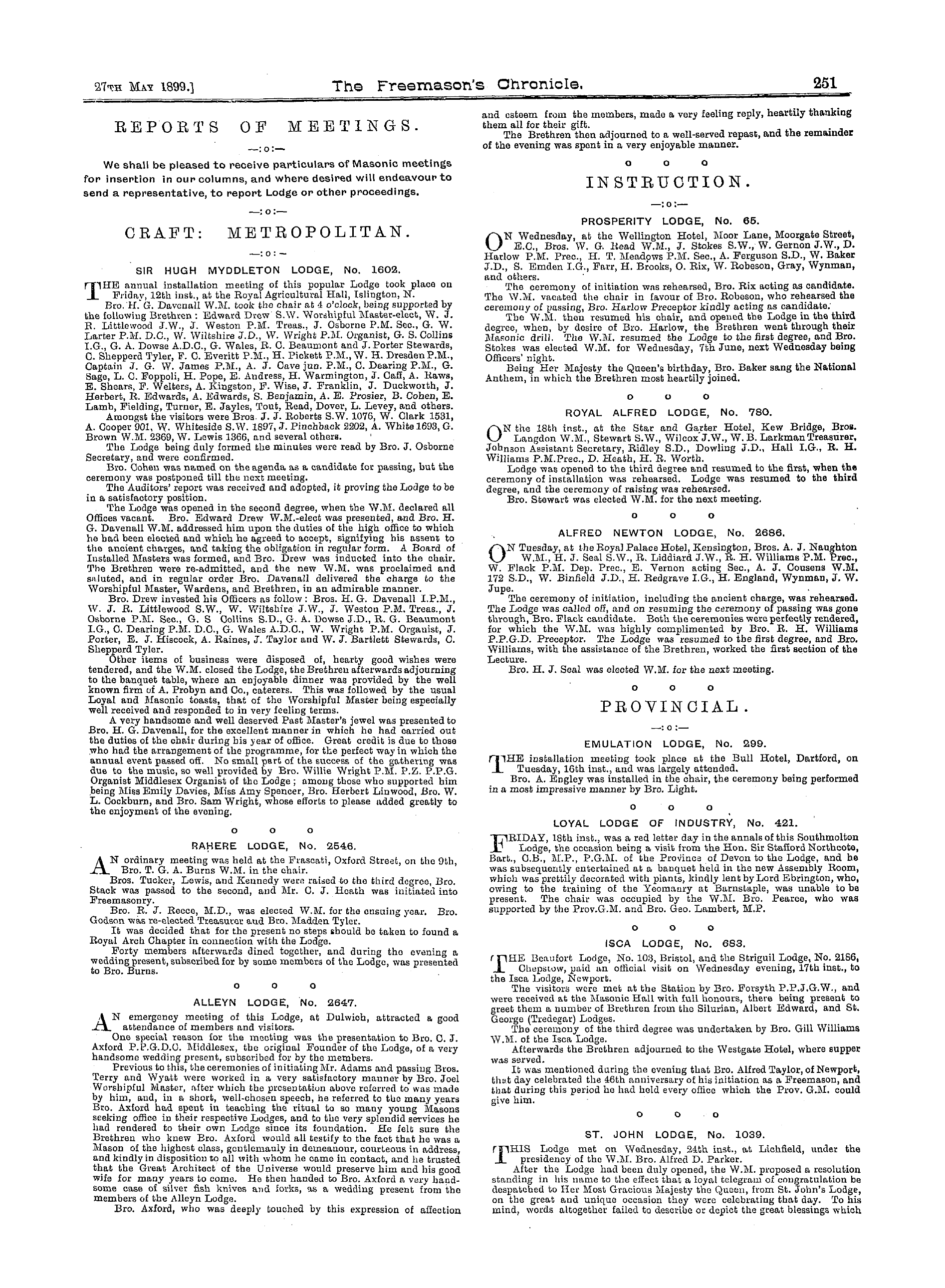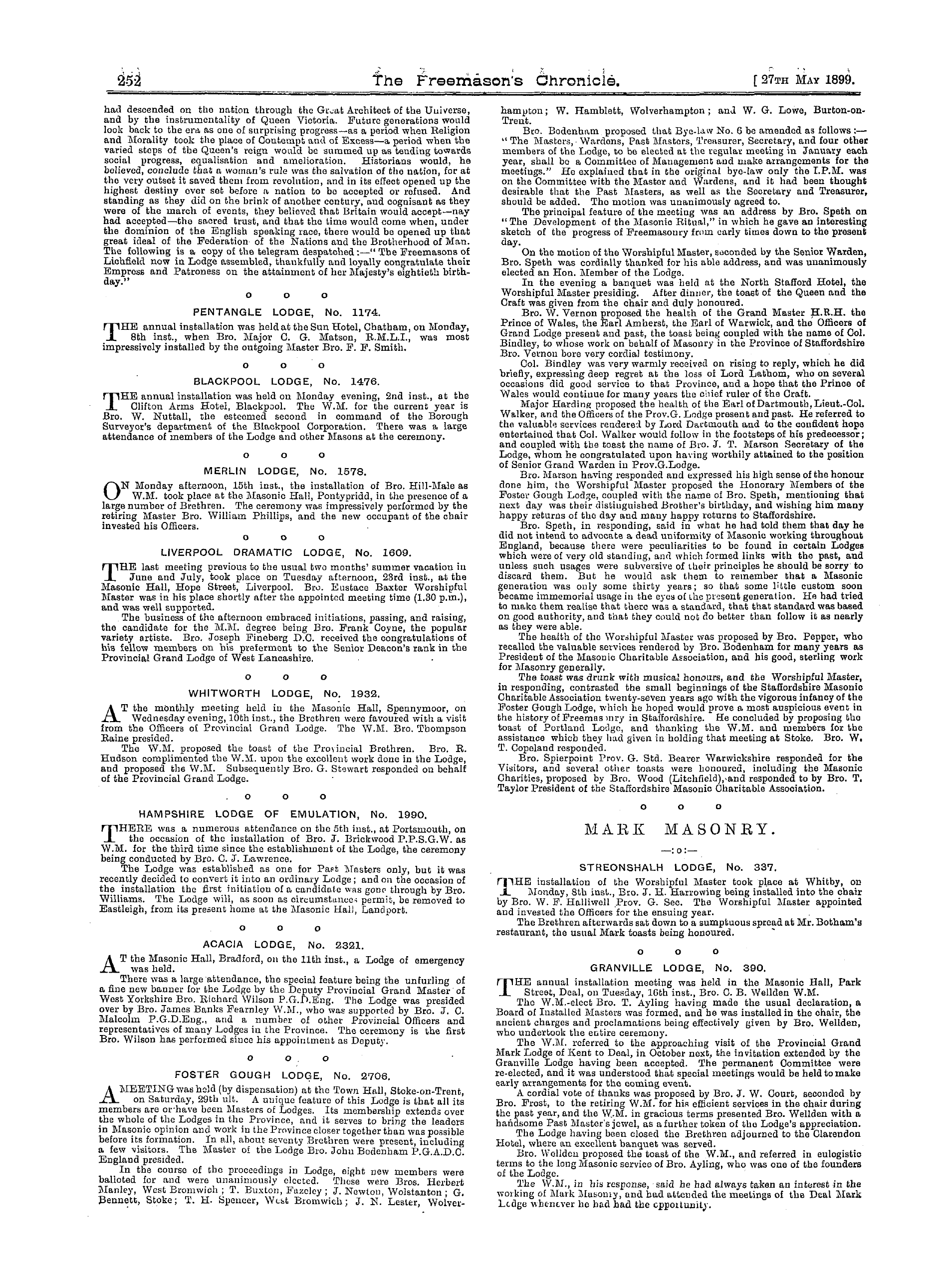-
Articles/Ads
Article WISDOM, STRENGTH AND BEAUTY. ← Page 2 of 3 Article WISDOM, STRENGTH AND BEAUTY. Page 2 of 3 Ad Untitled Page 1 of 1
Note: This text has been automatically extracted via Optical Character Recognition (OCR) software.
Wisdom, Strength And Beauty.
building as it were a monument likely to withstand the shocks of time . Look at the Pyramids ; what more stable than they and the Parthenon , which has been used as a powder magazine , the contents of which even have exploded , and yet it remains . Those readers of the I . M . R ., who have read Mr . Henry Holiday ' s lecture
on the Parthenon , and who have seen his beautiful model of the building as restored by himself , can realise its stability . Look at the area of its grand columns at their base , thirty-three feet , an area almost unequalled in the history of that particular epoch . The Pantheon at Rome , though a majestic building , sinks into
comparative insignificance beside the Parthenon , though both are much of the same size . Why ? Because tbe pillars of the Pantheon are smaller and taller , because they are more constructive . Take again the chapel of St . John in the Tower , how
grand and strong are its columns , though it may be whispered that this was due to clumsiness of the masons rather than to anything else . But the principle applies wherever one looks . Does a brick and slate cottage look as well as a rubble and thatch ? Which looks the better ? The rubble and thatch
undoubtedly . Why ? Because the walls are thicker , the roof is thicker , and thus solidity is and always will be more pleasing than mere flirnsiness . Therefore , to add grandeur to the building , stability is necessary . But there is yet another kind of strength which is indispensable to the Perfect Temple , and that is the
strength of material , and by this is implied not the mere physical strength , but rather the aesthetic strength gained by the use of striking or costly material , as was the case in the building of King Solomon ' s Temple . And the first consideration of this is size . A wall composed of large stones has more dignity than one
composed of small ones , and the Egyptians knew this well when they reared their obelisks and memnons . What is it strikes the observer on the embankment , of Cleopatra ' s Needle , apart , of course , from its age ? It monolithic grandeur ; that indeed was the chief difficulty in transporting it to England . Other buildings ,
like Temple Bar , for instance , can be taken down and re-erected with but little trouble ; but the monolith required care and careful forethought to preserve it intact during its eventful voyage . Such portions of the Temple itself as required stonework were supplied with the largest available blocks—blocks which indeed
would strike terror into the heart of the modern contractor . Baalbec again boasts stones , to again quote from Mark Twain , " as large as a street car , " and probably weighing as much as some of the largest girders ever lifted by our latter day machinery . Then came pillars whose shafts are of a single stone ; are they
not always more striking than if composed of several parts ? Have any of the readers of the I . M . R . ever noticed the magnificent hexagonal monolithic shafts of the pillars supporting the portico at Secunderabad Station ? They are a very sermon in stones on
the subject of strength . But this massiveness of stone is more or less lost to us in the present day , and we have to thank our Gothic Architects for the loss ; they , however beautiful were their buildings , " and they are unquestionably the finest examples of architecture the world has seen , laid over-much stress upon con-
Wisdom, Strength And Beauty.
structive skill and ornament , and thus lost to us one of the most important features in true architecture . Apart from mere size , the question of the value of the materials now arises—and that is an important one . People will flock to see the Queen's Crown , in the Towev of London , and will wonder at its beauty and jewels ,
but who would care to step across the road to see a model equally as beautiful , but an imitation ? Again , wherein does the Taj at Agra attract its visitors ; its proportions and shape are much the same as other Moslem structures ; it is not the building that attracts , it is the marble , and the agate and other precious stones
used to adorn ib , aud it was considerations such as this which led to the lavish employment of cedarwood , brass , gold and silver in the building of King Solomon ' s ' Temple . True it is that wood was perishable , but the ease with which it lent itself to carving , its costliness ancl the evidences of labour bestowed upon it were
sufficient justification for its employment in the Temple . As of wood , so of brass , gold and silver . Thus we have seen how necessary both the skill of construction and the solidity , stability and strength of materials are to the perfection of the building ; but yet remains the most important hand of all , the hand of the skillful architect who is to combine bis forces with the other two
in one harmonious whole . ( iii ) BEAUTY . Under this head may be classed those dispositions of the two former sections which meet the eye as work of art . It is essential that Beauty should adorn the edifice before it can be called an
architectural effort . But what may be called the Beauty of an edifice and wherein may it be exemplified ? This is indeed a hard question . It may consist in the proportion of the length to the breadth and height , in the form of the supports or pillars , or the artistic embellishments of its different parts .
" Referring again to the Parthenon , we have an example of perfect proportions in architecture , and one where the adornment of beauty lies in simplicity . Supposing even its columns were square and mouldings flat , even then the Parthenon would not cease to attract , so well balanced are its several proportions of
length , breadth and height . So again is it with the Gothic Cathedral , though in a far different manner . Here we see the height of one part contrasted with that of another , the central aisle towering over the side aisle , and duly subordinating it to its level as a part and adjunct of the whole building . In fact a very
barn , provided it be well proportioned , has an artistic beauty ; but if to this ornament be added in a fitting manner , then it bids fair to be a work of art and worthy to be ranked among one of the noblest works of man ; or again a building whose construction is not ornamental can by sheer force of added ornament become
an architectural achievement . For instance , the proportions of Solomon ' s Temple were hardly such as would find favour with the present day architect , or even with his Greek or Roman predecessor ; yet by dint of the lavish and costly added ornament it became at the time it was built quite one of the wonders of the world .
Ad00902
Royal Masonic Institution , for Girls . Offices—5 Freemasons' Hall , Great Queen Street , London , W . C . Chief . Patroness— HER MAJESTY * THE QUEEN . Grand Patron and President—H . R . H . THE PRINCE OF WALES , K . G ., & c , M . W . G . M . Grand Patroness— -H . R . H . THE PRINCESS OF WALES . Bankers—LONDON & WESTMINSTER BANK LTD . ( BLOOMSBURY BRANCH ) , HIGH HOLBORN , W . C . 1958 Girls haVe been provided With Education , Clothing , and Maintenance , the full number of Girls hoW receiving its benefits being 265 . The 112 th Anniversary Festival will take place in May next , under distinguished Presidency . F . R . W . HEDGES , Secretary , 5 FREEMASONS' HALL , LONDON , W . C . Registered Office Telegraphic Address : "Girlands , London . " Telephone No . 2952 Gerrard ,
Note: This text has been automatically extracted via Optical Character Recognition (OCR) software.
Wisdom, Strength And Beauty.
building as it were a monument likely to withstand the shocks of time . Look at the Pyramids ; what more stable than they and the Parthenon , which has been used as a powder magazine , the contents of which even have exploded , and yet it remains . Those readers of the I . M . R ., who have read Mr . Henry Holiday ' s lecture
on the Parthenon , and who have seen his beautiful model of the building as restored by himself , can realise its stability . Look at the area of its grand columns at their base , thirty-three feet , an area almost unequalled in the history of that particular epoch . The Pantheon at Rome , though a majestic building , sinks into
comparative insignificance beside the Parthenon , though both are much of the same size . Why ? Because tbe pillars of the Pantheon are smaller and taller , because they are more constructive . Take again the chapel of St . John in the Tower , how
grand and strong are its columns , though it may be whispered that this was due to clumsiness of the masons rather than to anything else . But the principle applies wherever one looks . Does a brick and slate cottage look as well as a rubble and thatch ? Which looks the better ? The rubble and thatch
undoubtedly . Why ? Because the walls are thicker , the roof is thicker , and thus solidity is and always will be more pleasing than mere flirnsiness . Therefore , to add grandeur to the building , stability is necessary . But there is yet another kind of strength which is indispensable to the Perfect Temple , and that is the
strength of material , and by this is implied not the mere physical strength , but rather the aesthetic strength gained by the use of striking or costly material , as was the case in the building of King Solomon ' s Temple . And the first consideration of this is size . A wall composed of large stones has more dignity than one
composed of small ones , and the Egyptians knew this well when they reared their obelisks and memnons . What is it strikes the observer on the embankment , of Cleopatra ' s Needle , apart , of course , from its age ? It monolithic grandeur ; that indeed was the chief difficulty in transporting it to England . Other buildings ,
like Temple Bar , for instance , can be taken down and re-erected with but little trouble ; but the monolith required care and careful forethought to preserve it intact during its eventful voyage . Such portions of the Temple itself as required stonework were supplied with the largest available blocks—blocks which indeed
would strike terror into the heart of the modern contractor . Baalbec again boasts stones , to again quote from Mark Twain , " as large as a street car , " and probably weighing as much as some of the largest girders ever lifted by our latter day machinery . Then came pillars whose shafts are of a single stone ; are they
not always more striking than if composed of several parts ? Have any of the readers of the I . M . R . ever noticed the magnificent hexagonal monolithic shafts of the pillars supporting the portico at Secunderabad Station ? They are a very sermon in stones on
the subject of strength . But this massiveness of stone is more or less lost to us in the present day , and we have to thank our Gothic Architects for the loss ; they , however beautiful were their buildings , " and they are unquestionably the finest examples of architecture the world has seen , laid over-much stress upon con-
Wisdom, Strength And Beauty.
structive skill and ornament , and thus lost to us one of the most important features in true architecture . Apart from mere size , the question of the value of the materials now arises—and that is an important one . People will flock to see the Queen's Crown , in the Towev of London , and will wonder at its beauty and jewels ,
but who would care to step across the road to see a model equally as beautiful , but an imitation ? Again , wherein does the Taj at Agra attract its visitors ; its proportions and shape are much the same as other Moslem structures ; it is not the building that attracts , it is the marble , and the agate and other precious stones
used to adorn ib , aud it was considerations such as this which led to the lavish employment of cedarwood , brass , gold and silver in the building of King Solomon ' s ' Temple . True it is that wood was perishable , but the ease with which it lent itself to carving , its costliness ancl the evidences of labour bestowed upon it were
sufficient justification for its employment in the Temple . As of wood , so of brass , gold and silver . Thus we have seen how necessary both the skill of construction and the solidity , stability and strength of materials are to the perfection of the building ; but yet remains the most important hand of all , the hand of the skillful architect who is to combine bis forces with the other two
in one harmonious whole . ( iii ) BEAUTY . Under this head may be classed those dispositions of the two former sections which meet the eye as work of art . It is essential that Beauty should adorn the edifice before it can be called an
architectural effort . But what may be called the Beauty of an edifice and wherein may it be exemplified ? This is indeed a hard question . It may consist in the proportion of the length to the breadth and height , in the form of the supports or pillars , or the artistic embellishments of its different parts .
" Referring again to the Parthenon , we have an example of perfect proportions in architecture , and one where the adornment of beauty lies in simplicity . Supposing even its columns were square and mouldings flat , even then the Parthenon would not cease to attract , so well balanced are its several proportions of
length , breadth and height . So again is it with the Gothic Cathedral , though in a far different manner . Here we see the height of one part contrasted with that of another , the central aisle towering over the side aisle , and duly subordinating it to its level as a part and adjunct of the whole building . In fact a very
barn , provided it be well proportioned , has an artistic beauty ; but if to this ornament be added in a fitting manner , then it bids fair to be a work of art and worthy to be ranked among one of the noblest works of man ; or again a building whose construction is not ornamental can by sheer force of added ornament become
an architectural achievement . For instance , the proportions of Solomon ' s Temple were hardly such as would find favour with the present day architect , or even with his Greek or Roman predecessor ; yet by dint of the lavish and costly added ornament it became at the time it was built quite one of the wonders of the world .
Ad00902
Royal Masonic Institution , for Girls . Offices—5 Freemasons' Hall , Great Queen Street , London , W . C . Chief . Patroness— HER MAJESTY * THE QUEEN . Grand Patron and President—H . R . H . THE PRINCE OF WALES , K . G ., & c , M . W . G . M . Grand Patroness— -H . R . H . THE PRINCESS OF WALES . Bankers—LONDON & WESTMINSTER BANK LTD . ( BLOOMSBURY BRANCH ) , HIGH HOLBORN , W . C . 1958 Girls haVe been provided With Education , Clothing , and Maintenance , the full number of Girls hoW receiving its benefits being 265 . The 112 th Anniversary Festival will take place in May next , under distinguished Presidency . F . R . W . HEDGES , Secretary , 5 FREEMASONS' HALL , LONDON , W . C . Registered Office Telegraphic Address : "Girlands , London . " Telephone No . 2952 Gerrard ,
